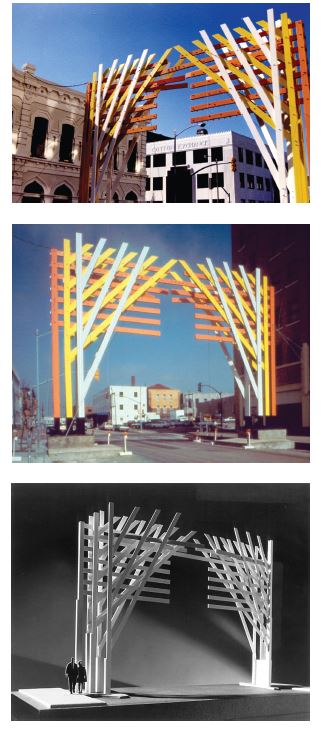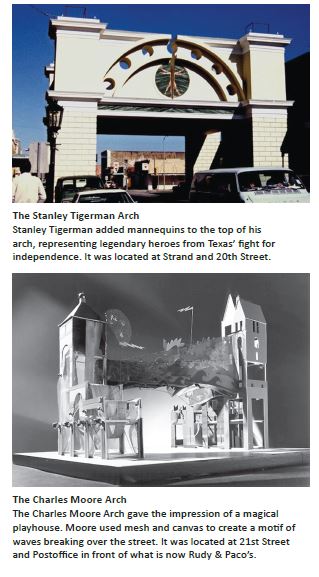 The whole idea for the Mardi Gras arches came about by accident. In the mid 1980s, fifth-generation Galvestonian Dancie Perugini Ware was working on a book about the island’s architecture when she came across a photograph that showed four colorful festival arches built on the Island for a special event in 1881.
The whole idea for the Mardi Gras arches came about by accident. In the mid 1980s, fifth-generation Galvestonian Dancie Perugini Ware was working on a book about the island’s architecture when she came across a photograph that showed four colorful festival arches built on the Island for a special event in 1881.
The festive arches were not built for Mardi Gras but instead were built for the 1881 Saengerfest, a statewide singing contest that was held on the island because a German singing club from Galveston had won the Texas title the year before.
Located at four points along Tremont (23rd Street) at the intersections of Strand, Market, Mechanic and Postoffice, these structures with their turrets arrayed with flying flags marked the festival’s parade route.
Ware proposed that rather than try to duplicate what was done in 1881, contemporary architects of international stature should be commissioned to design fantasy structures for the 1986 Mardi Gras. Seven renowned architects were invited to design street spanning “fantasy arches” for Mardi Gras that year.
Cesar Pelli, who was at the time one of the most influential architects and formerly the dean of the Yale School of Architecture, was one of those who accepted the challenge to design an arch.
He devised an easily assembled angular and monochromatic arch constructed of wood. Described by Pelli as consisting of four elements—wood, paint, sunlight and sky—the arch stood 35 feet tall and 48 feet wide, with a 19 foot-tall opening.
The emphasis was on color - luminous shades of yellow, orange and white - as well as form. The brightly painted, parallel line forms layered to produce a complex pattern of grids.
The span designed by Pelli was very one-dimensional. While construction was going on, it was said to resemble nothing more than large popsicle sticks that had been pasted together to form a flat model of the underpinnings of an arch.
His intention was to include sunlight and sky together with wood and paint to form the structure. Pelli’s arch formed a kind of aboriginal latticework gate that recalled two trees with intertwining branches.
The Pelli Arch was located at the corner of 21st Street and Mechanic in the Strand Historic District. At night the arch was lit by a series of colored light bulbs to help emphasis all horizontal pattern grids.
 Originally created as one of the temporary fantasy monuments to be dismantled after one month, the arch proved such a popular attraction that it was left up for six months.
Originally created as one of the temporary fantasy monuments to be dismantled after one month, the arch proved such a popular attraction that it was left up for six months.
The revival of Mardi Gras in Galveston was celebrated in 1985 to mark the grand opening of The Tremont House. The arches were erected for the 1986 celebration and the project captured national attention in 1987 when "Arches for Galveston,” an exhibition of architectural renderings, photographs and models of the Galveston arches, was displayed at the Cooper-Hewitt, Smithsonian Design Museum in New York City.
The arches became a focal point of the renaissance under way in Galveston, where landmark buildings were being restored and age-old traditions, such as Mardi Gras, were revived.
Now decades later, only the Boone Powell Arch remains standing in downtown Galveston in front of The Tremont House, but the memory and legacy of the fantasy arches will live on in Galveston’s history forever.
Mardi Gras Arch Locations
Stanley Tigerman - 20th Street and The Strand
Cesar Pelli - 21st Street and Mechanic
Charles Moore - 21st and Postoffice
Eugene Aubry - 22nd Street and The Strand
Michael Graves - 23rd Street and The Strand
Boone Powell - 24th Street and Mechanic
Helmut Jahn - 25th Street and The Strand